Introduction
Last semester I learned about coastal and tundra grasses, primarily beach rye grass, and the various culturally distinct ways people have ingeniously transformed the fiber into containers, clothing, coverings, and fabrics. This semester I wanted to turn my attention to materials from the boreal forest. As I remain most interested in everyday objects used for domestic life, of all the materials from the boreal forest, birch bark rises as an instantly recognizable and essential material.
Paper birches are an important tree in the circumboreal and sub-arctic regions of the northern hemisphere – in some areas you could define them as a keystone cultural species. Wherever birch grows, the peoples of earlier times depended on the tree for numerous life giving attributes. Every part of the tree seems to give life; the sap, cambium, outer bark, buds, branches, twigs, new leaves have many uses and medicinal qualities. Each of the elements warrants a study all its own.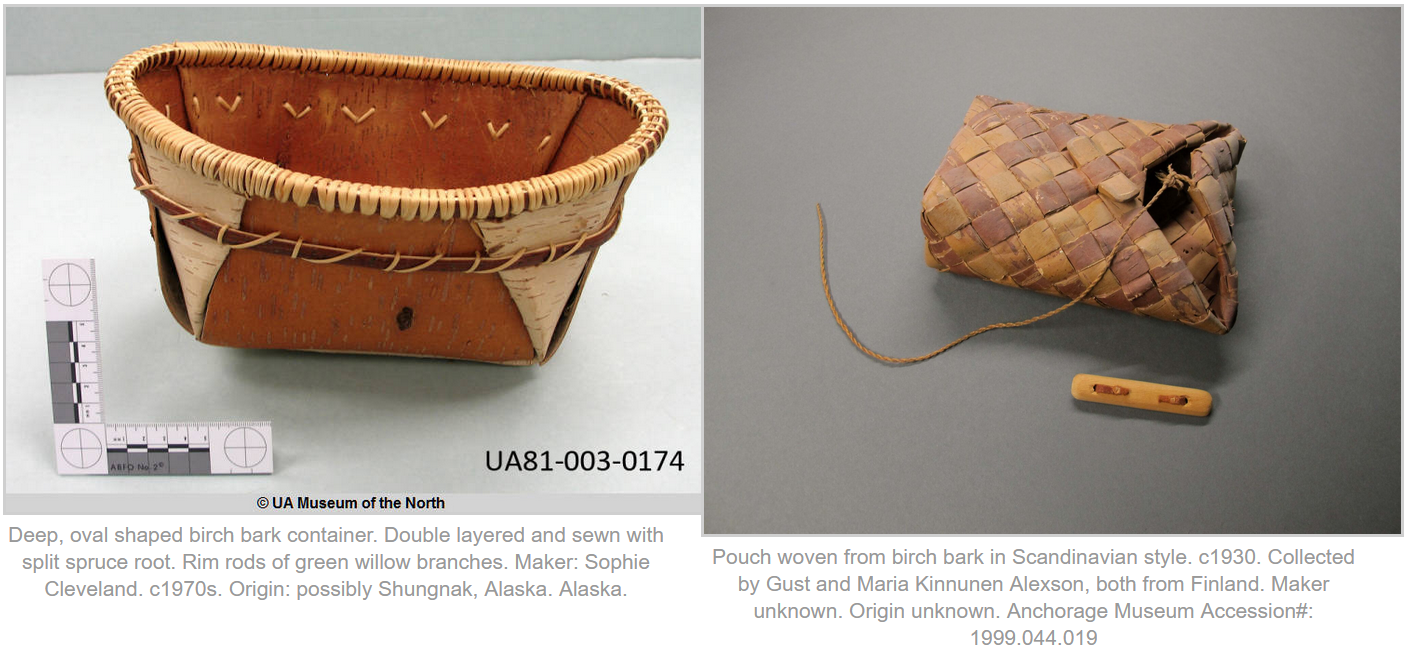
Items made from birch bark are exceedingly functional, where the maker harvests the materials and designs the object for the intended purpose. In North America, people fashioned birch baskets and other items by folding and stitching birch bark where in parts Europe, Scandinavia and Western Russia used strips of birch bark to weave these items.
 Around Anchorage, evidence of birch bark harvesting began to stand out in the pockets of park land where I walk. I started to notice black banded birch trees along the sides of the road, even in the bustle of major intersections.. These birch trees drew my attention and curiosity. Non native people I spoke with felt as though the removal of the bark marred the tree, tainting the visual tapestry of the landscape as a whole, and worst of all, that removing the bark hurt the tree.
Around Anchorage, evidence of birch bark harvesting began to stand out in the pockets of park land where I walk. I started to notice black banded birch trees along the sides of the road, even in the bustle of major intersections.. These birch trees drew my attention and curiosity. Non native people I spoke with felt as though the removal of the bark marred the tree, tainting the visual tapestry of the landscape as a whole, and worst of all, that removing the bark hurt the tree.
I understood their confusion. I too had been taught to never, ever remove birch bark from a tree as that could kill it. I too was conditioned to see nature as a backdrop that needed protection from humans, as we were the most powerfully destructive force. This tension of misunderstanding, the cultural clash of living next to nature, rather than part of it is an emblematic relic of an aesthetic tradition. Colonial attitudes saw wilderness as something to subdue and those sentiments continue as ideal landscapes are reinforced and passed on through western literature and culture. What is nature for? Who is nature? Where is nature?
It’s possible that we can reconcile this confusion; recognize that this insider-outsider relationship with nature is ongoing, malleable and therefore changeable. Together, we can interrupt our conditioned belief to see where we participate or perpetuate these conceptions. Therefore, this project has become more of an inner journey to better understand my own limitations when answering these questions.
Nowadays, harvesting birch bark doesn’t seem necessary, yet the bark from these trees was harvested intentionally. Perhaps it was needed to make a container for personal use or to make a basket to sell to support someone’s livelihood. That they are close to trailheads or roadways simply means these trees were easier to access.
I don’t know who harvested the bark from these trees, or for what purpose. What I can see is that, in most cases, the bark was removed expertly, and many of the trees are still living. I also encountered some trees that did not survive the process.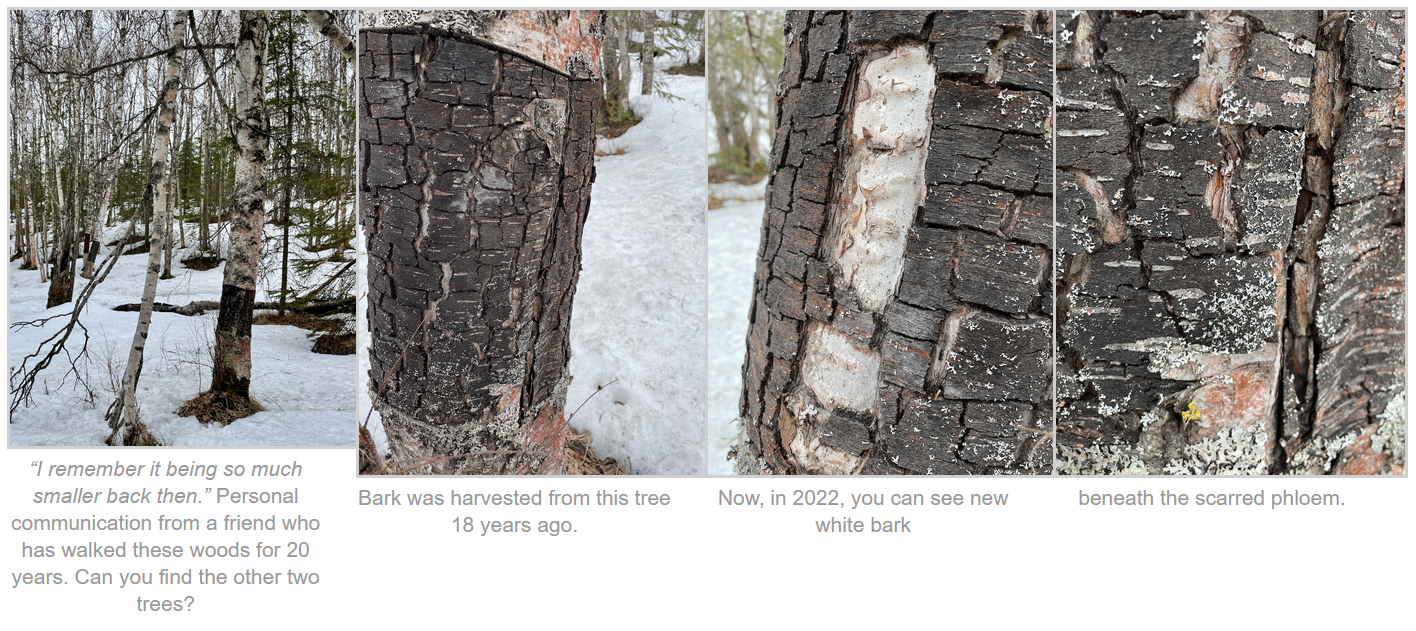
In order to understand this process, I needed to learn more about the tree itself and the unique qualities that make the birch bark so useful. Through this process, I found documented stories, tellings and explanations, some of which I included here. There are accounts of birch bark use from all across the global north. That is where paper birch trees grow and have helped people survive for millennia. These trees may be different species but bark of birch trees has been made baskets and containers to keep or cook food, become cups and plates, house coverings, canoes, cradled children and become footwear and many more useful articles. The bark has also served as medium for communication, mapping and recording knowledge.
While it is tempting to draw inspiration and fold in stories and uses of birch from the entirety of the range of the birch tree, that’s outside the scope of this project. Entire books are dedicated to the birch tree, including British ethnobotanist Anna Lewington’s ‘Birch” which was released in 2018. This book showcases many species of birch as part of a botanical series published by Reaktion Books Ltd. broadly exploring cultural and social impacts of plants, albeit from a primarily western European point of view. Silver birch is the the national tree of Finland and Russia, where weeping birch is the national tree of Sweden. Alaska’s state tree may be the Sitka spruce, but growing right alongside is the dependable paper birch.
Betula species in Alaska
Birches are the namesake of the Betuleacea family. This small but prevalent family also includes the genus Alnus (alder), it’s closest relative and also grows extensively in Alaska. Additional genera include Corylus (hazel) and Carpinus (hornbeam) species of both also grow in temperate areas of North America, Europe and Asia), Ostrya (hophornbeam of Asia), and Ostryopsis (endemic to China, 虎榛子属 hazelnut).
Birches are early successional trees, helping to establish conditions for a forest to grow over time. Across Alaska, paper birches are a prevalent tree species often growing alongside white spruce (Picea glauca) and black spruce (Picea mariana). Birch trees are considered to be short-lived in comparison to other tree species with an average lifespan up to 80-100 years and an average trunk diameter of 20-22 cm. In exceedingly ideal conditions they have been found to live over 200 years and achieve a diameter of over 70 cm. (Viereck, 2007:164)
Two species of birch stay small and shrubby, even tight to the ground in alpine conditions; resin birch (B. glandulosa Michx.) and dwarf arctic birch (B. nana L.). These smaller birches do not grow large enough to have distinctive peeling white bark suitable for harvesting, though they share the same plant compounds which valuable in other ways. Likewise, a third lesser known species (not included in Viereck, 2007) is water birch (B. occidentalis Hook.) which is a shrubby, small tree which dwells in riparian margins and tends to stay under 10-15m tall. (Gucker, 2012: online).
This is where it gets confusing. There are numerous accounts of white paper or canoe birch (Betula papyrifera Marshall) across Alaska yet the range described for B. papyrifera by Viereck (2007, p167) is restricted to the southeast of Alaska only. Alaska paper or resin birch (Betula neoalaskana Sargent), according to Viereck (2007, p166) is the dominant paper birch tree, covering nearly the entire state minus the southeast. A third paper birch, Kenai or Black birch (Betula kenaica W.H. Evans) has a range limited to southcentral Alaska. Still, some publications about birches in Alaska refer either only to B. neoalaskana where others only recognize B. papyrifera. Why is this?
A recent 2020 study, titled ‘How Many Tree Species of Birch Are in Alaska? set out to determine the genetic origins of these three trees to improve criteria for wetland delineation. The authors found, based on their (somewhat limited) samples from Alaska and Alberta, strong genetic evidence of B. papyrifera detected in southeast Alaska with the range extending east. (Mckain et al. 2020, p7). Also, there was not as much hybridization as they anticipated, only detecting two possible hybrids, one near Anchorage and one near Skagway. Interestingly, they “found no convincing genetic evidence for two clades (B. neoalaskana and B. kenaica) within Alaska although, again, this may be attributed to undersampling. (Mckain et al., 2020, p6). They also confirmed that, morphologically, that these trees are nearly indistinguishable, particularly B. papyrifera and B. neoalaskana. (Mckain et al. 2020, p6)
This study further correlated the genetic lineage of B. neoalaskana/B. kenaica to the circumpolar complex (diploid) that includes the Asian species. B. papyrifera seems to be genetically separate (pentaploid) from this complex. (Mckain et al. 2020, p5,p7); (Furlow, 2022: Flora of North America).
Therefore, they concluded that the wetland species delineation list for Alaska be updated to include B. neoalaskana, and encouraged further investigation into the genetic differences between B. neoalaskana and B. kenaica by including more samples taken from a greater range within Alaska and compared to eastern Asian, particularly Siberian birch trees.
If I may be so bold, I therefore suggest that, in most of Alaska, birch bark is harvested from B. neoalaskana, except for in southeast, where the dominant birch tree would be B. papyrifera. Where the ranges overlap, (or perhaps in proximity to horticultural plantings of B. papyrifera such as near a city like Anchorage), there may be conditions that allow for hybridization.
These maps, pulled from GBIF, are contradictory to the above findings but do not diminish the extensive range and ethnobotanical impact that birch trees have in North America.

Why birch bark?
Birch bark lasts an incredibly long time. An article addressing how to conserve birch bark artifacts analyzed the cork (phellem) by weight (wt%) (Klügl & Di Pietro, 2021, p2):
- 36.2 wt% of the cork (phellem) is composed of suberin, a biopolymer which together with the closed nature of the cells, is responsible for its water repellency.
- 14.3 wt% is lignin
- 10.3 wt% is composed of polysaccharides
- 32.2 wt% are extractives, which are located in the cells. “In particular the thin-walled cells are filled with betulin, a triterpene, while the thick-walled cells are filled with phenolic components.” (Klügl & Di Pietro, 2021, p2)
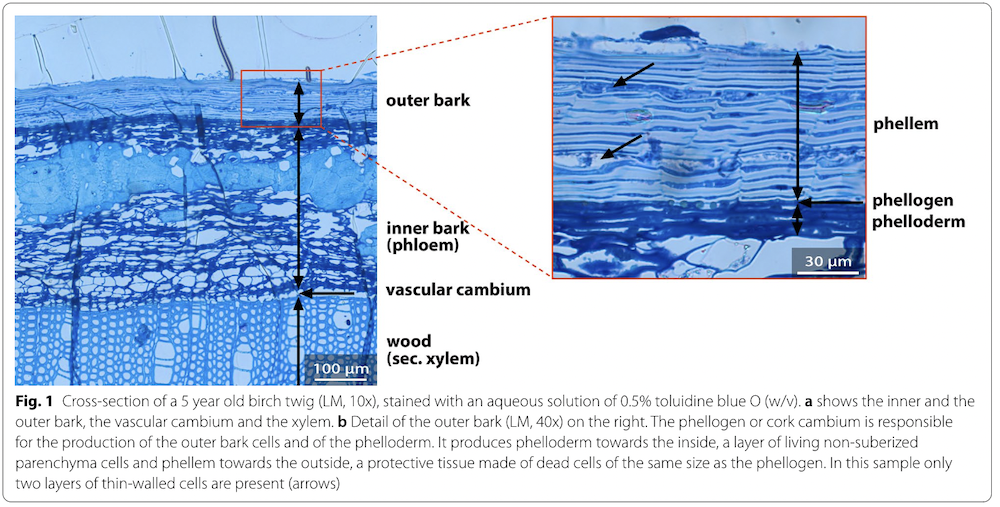
Dena’ina birch bark harvesting

I imagine each person who harvests birch bark notices specific things about the tree, aiding in the educated decision of whether or not to cut into the tree. It is clear that not every birch tree will easily shed its bark, and that good birch trees for bark harvesting are not common making the items made from them just as special.
In the Dena’ina language, birchbark is nichił in the Dena’ina language which is the same word for the traditional winter home as birch bark is the protective material that covers the house. According to Priscilla Kari who wrote ‘Tanaina Plantlore: Dena’ina nichił applies to birchbark in all of the Dena’ina dialects other than in the Upper Inlet, where both paper birch tree and bark are q’ey. (Kari 1995: 43-44) In the other dialects, birch trees are q’eytsay in Inland and Iliamna Dena’ina while called chuq’eya in Outer Inlet Dena’ina. Interestingly and linguistically, q’ey is a root word found to be part of the words for willows, q’eylish in Outer Inlet or q’eylu in Upper Inlet. (Kari 2013:49-51)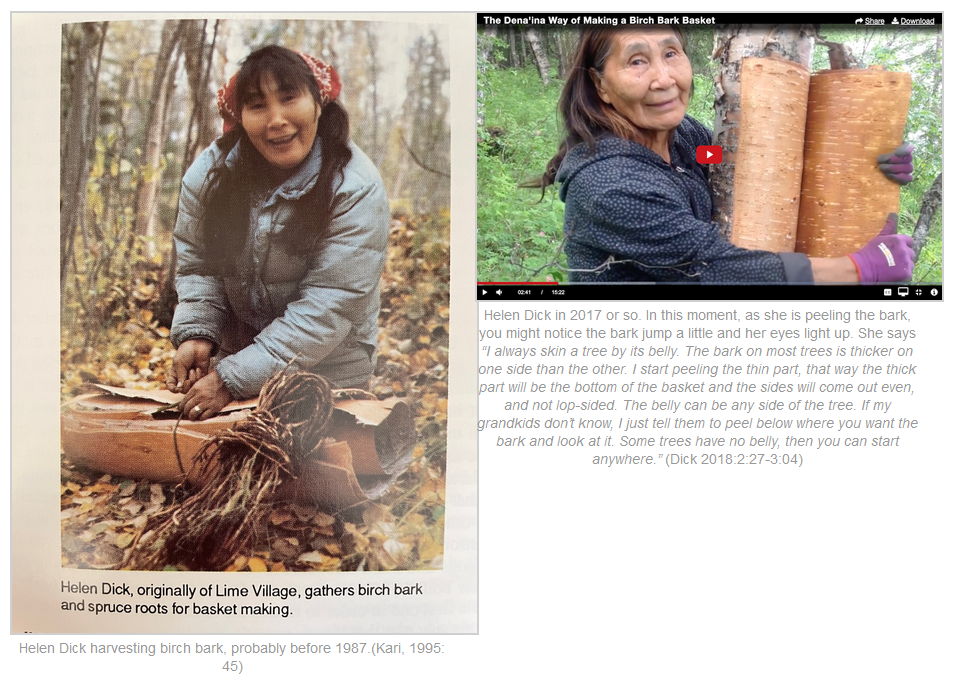
Inland Dena’ina Elder and basket maker Helen Dick of Lime Village shares and demonstrates birch bark basketry in a video produced by the U.S. National Park Service, Lake Clark National Park and Preserve. Helen Dick shares about knowledge transmission; how she learned from her Grandma, and her family learns from her. “Every Dena’ina girl learns how to make a birch basket” (Dick, 2018: 1:20-1:30) She speaks of current and past uses for birch bark, and shares harvesting techniques. In the video, you see her harvesting in different seasons while she provides commentary. You can see that the bark releases easily when the time of year is right, and that the bark stays tight to the tree when you harvest out of season. “I peel the trees in fall, but they are stingy for their bark. It takes a long time to peel just one tree.”
“I always thank Naq’deltani for the bark when I am done. We didn’t grow the bark and we have to be thankful for everything.”~ Helen Dick, 2018: 4:31-3:40.
Naq’deltani is Dena’ina for God or ‘the one above us’ (Kari, 2013: p312). Harvesting birch bark is a tricky piece of knowledge to share. birch trees, while not rare, do have extremely variable bark and every birch tree has suitable bark for harvesting. There are qualities that a maker seeks for a project that are scrutinized before harvest. For most basket projects, the bark cannot be too bumpy or dense with lenticels. Too thick it will crack, too thin it will tear.
A few more accounts from around Alaska
“The best trees have marks on them that look like swallows. They call these marks tulugaġnat in Inuipiaq Eskimo.
These marks are actually the places where the lateral branches were attached to the main trunk of the birch tree. Another thing to look for are the small markings or cross-grain on the bark of the birch tree. These cross grain marks must not be long. The cross graiining is called iri. If these markings are long, the bark will crack all along those lines and break easily. ” (Gray et al, 1990: p3)
“Wait, I see something: We whistle along the hillside.
Answer: loose, half peeled bits of birchbark, hissing in the wind.” ~Make Prayers to the Raven, A Koyukon View of the Northern Forest, Nelson 1983, p53)
In the Koyukon language, birch is ‘kk’eeyh’ and has a powerful spirit, ‘biyeega hoolaanh‘ which requires great respect. Back in the early 80s, Koyokun knowledge bearers from the village of Huslia of Interior Alaska told Richard Nelson that “Birchbark is not peeled from a living tree in the winter, because this leaves the tree naked to the cold and will bring on a frigid weather. If someone does remove the bark it should be smeared with black ashes to negate the bad effects. It is more proper to bring a birch log inside, thaw it, then strip the bark, and then bury the log in the snow to protect it from exposure to the cold air. “ (Nelson, 1983:53).
These are just three accounts that include descriptions of birchbark in Alaska.
Ethical Harvesting and Access considerations
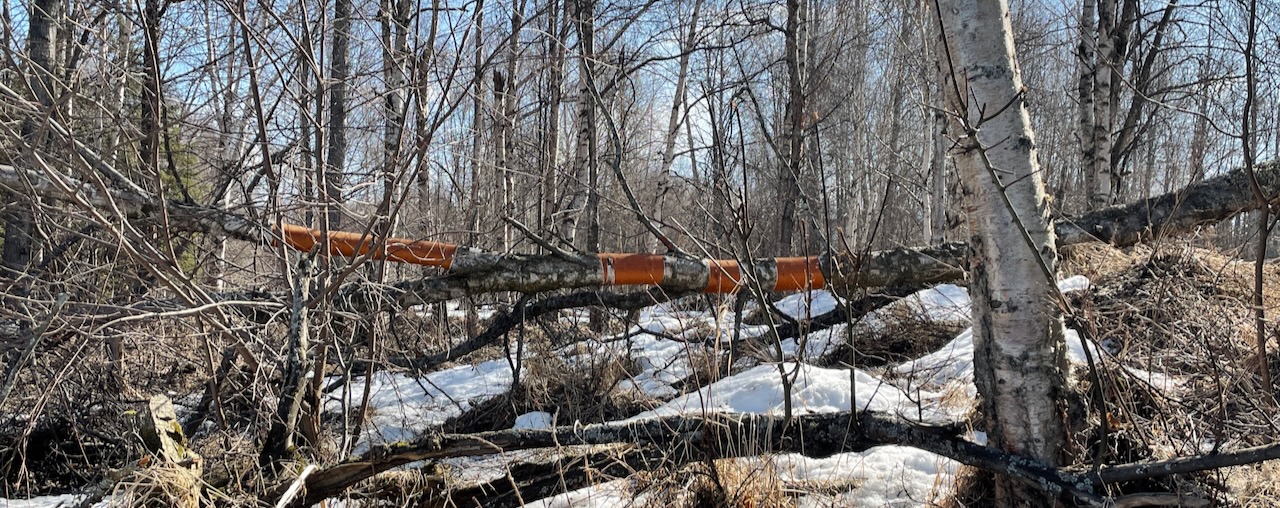
There are good reasons why birch bark harvesting is shrouded in mystery and this project isn’t meant to encourage it. Harvesting birch bark may not kill the tree, however many say that it weakens the tree by exposing the tree to disease. Also, if done incorrectly, you will kill the tree by damaging the important cambium, essentially the veins or vascular system, transporting the sap, the lifeblood of the tree, from roots to branches.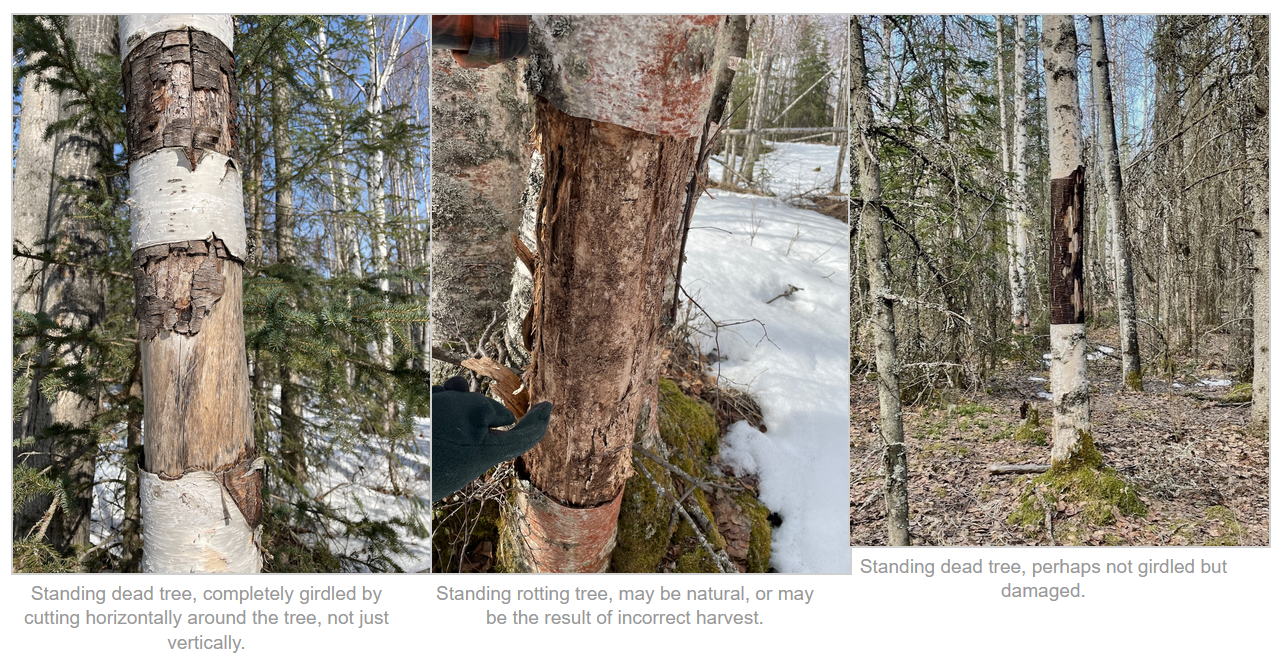
Interestingly, while I was paying attention to this practice, I was surprised to find not one but four trees along a path I frequent with fresh bark removal by an unknown person. This was in late March, which I understand now not to be the ideal time of year.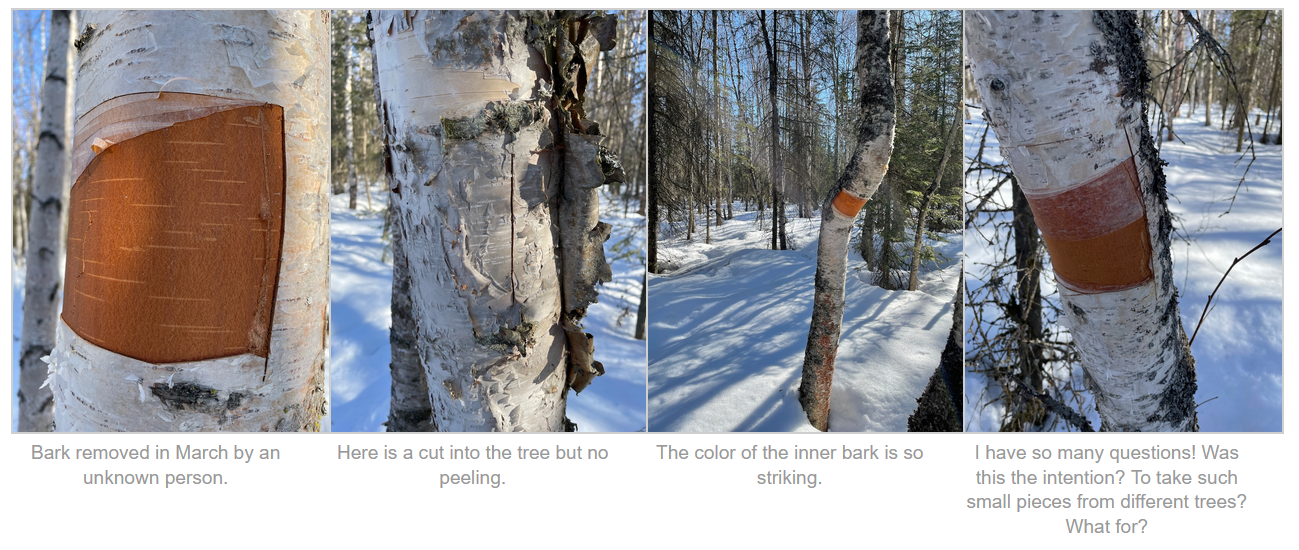
That this bark was removed in March is surprising – yet it is also surprising that the Department of Natural Resources lists that the limited time for harvesting bark is between April and May. (DNR, 2022, online) This may be true for localities further south, as the correct time to harvest bark is in early summer. Perhaps you noticed in the background where of Helen Dick is harvesting birch bark, that there are wild roses blooming? That is an excellent indicator of the time of year. Images of people harvesting bark show trees in full but fresh green leaf with wild roses blooming in the background. Some say that once the mosquitos are awake, that is the signal that the bark is ready.
As a non-timber forest product, birch bark is regulated. Birch bark intended for commercial purposes is limited to 300 sheets of bark, each may be up to 10sf, per year per permit holder. Each sheet is valued at 3$ (DNR, 2022, online).
I started wondering about materials and access for people who practice traditional birch basketry. How do people who live in Anchorage, who may not have access to acreage harvest birch bark for their projects? These images below are just a sampling of the many trees I encountered. Appreciating the contemporary context in which birch bark is used today, mainly as a celebrated skilled art and craft in the form of basketry which is also a livelihood.
In modern day Anchorage
I wanted to locate an undisturbed area of forest within the Anchorage area and this proved more challenging than I imagined to prove. I spent sometime sharing screens with an expert in aerial photography, but I would have needed layers of information including forestry records, and historical accounts to determine if my best guesses were in fact intact forest within the Anchorage bowl.
A bigger question is why did I want to find this intact forest with evidence of birch bark harvesting?
Having read “Their Markers as they Go”: Modified Trees as Waypoints in the Dena’ina Cultural Landscape”, I admit I felt the sense of urgency to document trees, and associated landscapes, before they were lost forever, either to memory or to development. Several things stand out to me from this article, primarily the following.
“Although the elusiveness of clear Dena’ina physical presence on the landscape may seem a largely cultural or academic concern, this phenomenon increasingly impacts Dena’ina life in new and often negative ways. Due to the subtlety of physical cues, public lands managers, operating under U.S. cultural resource law and policy, often have poor documentation of Dena’ina traditional land and resource use sites. Surveys for evidence of human activity on these lands mainly seek archaeological signals, which can be elusive in this context. In turn, traditional use areas tend to be overlooked in federal and state inventories. In planning for future land uses, even well-established resource harvest sites of the Dena’ina are at times excluded from assessments of“cultural resources”within public stewardship.” ~Their Markers as they Go”: Modified Trees as Waypoints in the Dena’ina Cultural Landscape, Deur, Evanoff and Hebert, 2020, p319.
That said, this is my curiosity and while it may be valuable on some level, I cannot undertake this exploration completely without entering into dialogue and coalition with representatives of the Dena’ina people who know this land. There are things about these forests and locations that they know deeply, some of which may not need additional attention brought towards it. For that reason, I am not captioning my photos with locations at this time.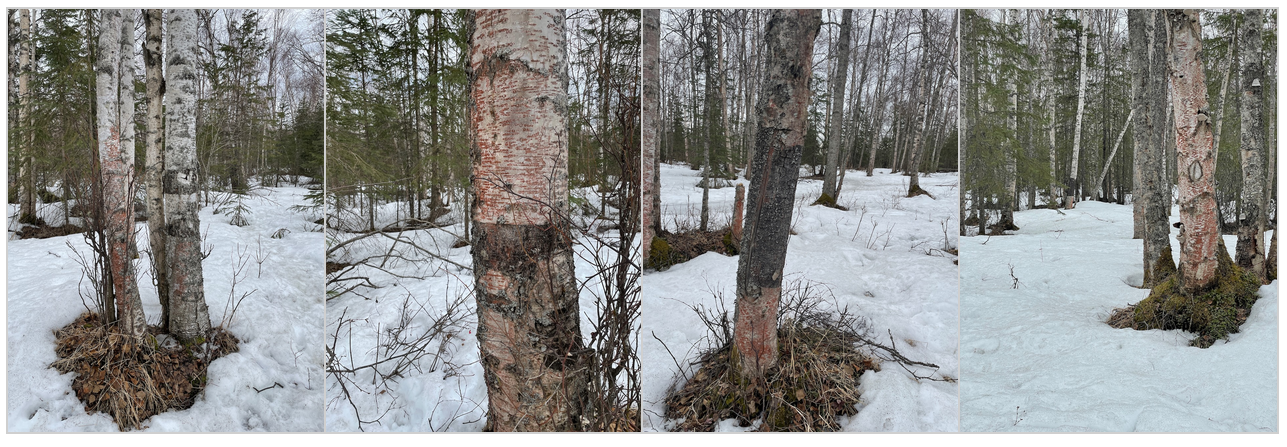
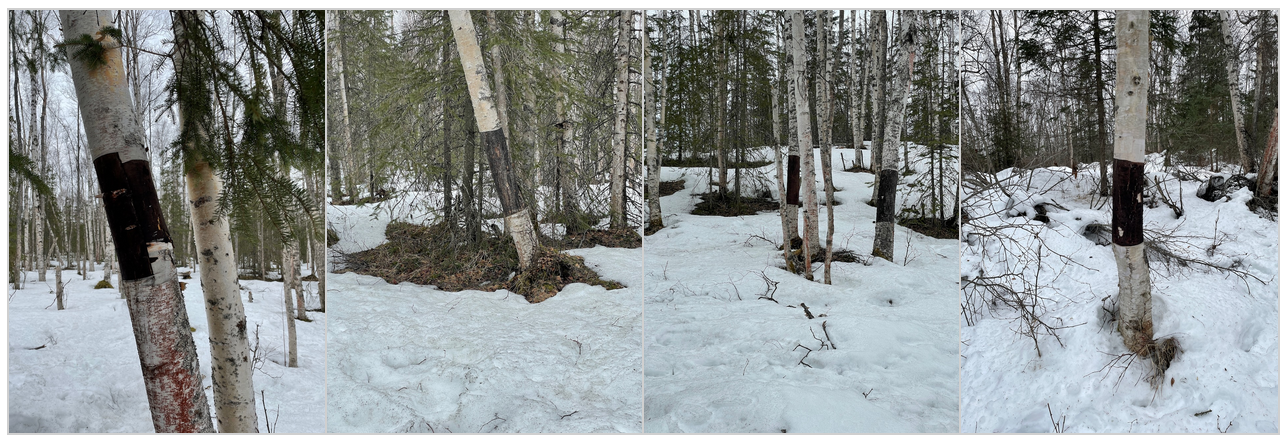
Seeking old trees
A classmate joined me on a snowshoe in a park area that is easily accessible. Based on Aerial photography over the last 70 years, I judged it had not experienced clear cutting. I can’t be sure that it was not altered in anyway as military activity was heavy in the 1950s. Whatever the case, the birch trees here are very old. As you can see from the images, the forest structure here is open. The birch trees are among the largest I have ever seen.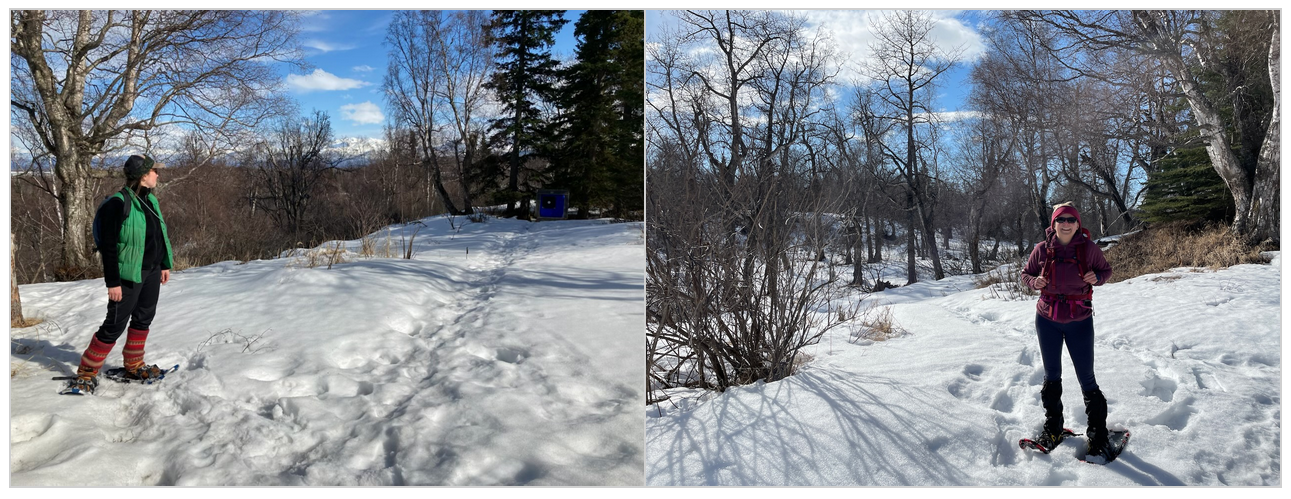

On these super-birches, I could not tell if bark had been harvested from them at any point. The open structure of the forest together with the snow pack made for easier traversing of the forest. We could see swaths of devil’s club, elderberry bushes, alder thickets, and beneath the trees, the awakening of spring forest plants. On one hand, it could just be the soils, elevation, sun exposure or other geographical features that led to this landscape. Or it could have been a managed landscape.
Conclusion
Documenting culturally modified trees is considered urgent in order to help identify and preserve valuable Indigenous cultural landscapes, adding to the historical relevancy that goes beyond structures or other defined and recognizable structures. Here in Anchorage, more needs to be done soon as we plow forward into full urbanization of the bowl. Possibly, this work is a kind of activism, but it needs to be entered into mindfully. There are a myriad of complex factors and questions that have arisen since I undertook this project.
- What are the current policies regarding culturally modified trees or culturally significant landscapes at the municipal, state and federal level?
- How do you go about finding archeological accounts in this area?
- Are archeological and timber surveys required for public or private development prior to clearing?
As a non-Native person, I may be imposing on a major issue which is not really mine to define. However, I do think that it’s ok that I’m looking at the birch trees, to shed a little understanding of the bigger picture and implied context by trying to know them and appreciate them for who they have become; to notice the subtleties that change as they recover from sharing their skin.
Finally, I like to think of part of them living somewhere else in the world, hopefully cherished if commodified, or hard working if still in use by the maker.
Research Literature
alaskawildflowers.us (2022) Published on the Internet https://www.alaskawildflowers.us/ [accessed 22 April 2022] https://www.alaskawildflowers.us/Kingdom/Plantae/Magnoliophyta/Magnoliopsida/Betulaceae/Betula_nana/Nana_08.html
Anchorage Museum (2022) Carrier, Baby Athabascan [online collection] http://onlinecollections.anchoragemuseum.org/#/search – 1977.001.001 [accessed April 30, 2022]
Anchorage Museum (2022) Scandinavian Pouch [online collection] http://onlinecollections.anchoragemuseum.org/#/search – 1999.044.019 [accessed April 30, 2022]
ARCTOS (2022) [online database] Alaska’s Digital Archives Identifier. Birch bark Tray. UA81-003-0174 http://arctos.database.museum/guid/UAM:EH:UA2016-006-0007 [accessed April 30, 2022]
UA Museum of the North (2022) [online database] Alaskas Digital Archives Identifier. Birch bark container. UA81-003-0174 https://vilda.alaska.edu/digital/collection/cdmg3/id/820 [accessed April 30, 2022]
DNR (Alaska Department of Natural Resources) (2022) [online] https://dnr.alaska.gov/mlw/lands/permitting/ntfp-commercial-harvest-permit/register/ [accessed 22 April 2022]
Deur, D., Evanoff, K. & Hebert, J. “Their Markers as they Go”: Modified Trees as Waypoints in the Dena’ina Cultural Landscape, Alaska. Hum Ecol 48, 317–333 (2020). https://doi.org/10.1007/s10745-020-00163-3
Dick, H. (2018) The Dena’ina Way of Making a Birch Bark Basket. National Park Service. Lake Clark National Park & Preserve Alaska. https://www.nps.gov/lacl/learn/historyculture/birchbarkbaskets.htm [accessed March 27 2022]
Furlow, J.J. Betulaceae. (2020) In: Flora of North America Editorial Committee, eds. 1993+. Flora of North America North of Mexico [Online]. 22+ vols. New York and Oxford. Vol. 3. http://floranorthamerica.org/Betulaceae Accessed April 22, 2022.
Furlow, J.J. Betula neoalaskana. (2021) In: Flora of North America Editorial Committee, eds. 1993+. Flora of North America North of Mexico [Online]. 22+ vols. New York and Oxford. Vol. 3. http://floranorthamerica.org/Betula_neoalaskana Accessed April 21, 2022.
Furlow, J.J. Betula kenaica. (2021) In: Flora of North America Editorial Committee, eds. 1993+. Flora of North America North of Mexico [Online]. 22+ vols. New York and Oxford. Vol. 3. http://floranorthamerica.org/Betula_kenaica Accessed April 21, 2022.
Gucker, Corey. 2012. Betula occidentalis. In: Fire Effects Information System, [Online]. U.S. Department of Agriculture, Forest Service, Rocky Mountain Research Station, Fire Sciences Laboratory (Producer). Available: https://www.fs.fed.us /database/feis/plants/tree/betocc/all.html [2022, April 22].\
Gray, M., Pulu, T.M., Newlin, A., Ramoth-Sampson R., (1990) Birch Bark Basket Making: Aimmiłiq Qiaġumik. Circumpolar Press, Anchorage, Alaska
eFloras (2021). Published on the Internet http://www.efloras.org [accessed 22 April 2022]*’ Missouri Botanical Garden, St. Louis, MO & Harvard University Herbaria, Cambridge, MA.
Kari, J. M. (2013). Dena’ina topical dictionary. 2nd Edition. Alaska Native Language Center.
Kari, P. R. (1995). Tanaina Plantlore Dena’ina K’et’una: An Ethnobotany of the Dena’ina Indians of Southcentral Alaska, 4th edn, Alaska Native Language Center, University of Alaska. Fairbanks.
Klügl, J., & Di Pietro, G. (2021). The interaction of water with archaeological and ethnographic birch bark and its effects on swelling, shrinkage and deformations. Heritage Science, 9(3), 1–15. https://doi.org/10.1186/s40494-020-00476-y
Lewington, A. 2018. “Birch.” Reaktion Books.
Mckain, M. R., Puzey, J., Olson, M., Wolf, P. G., Rowe, C. A., & Lichvar, R. W. (2020). How Many Tree Species of Birch Are in Alaska? Implications for Wetland Designations. https://doi.org/10.3389/fpls.2020.00750
Nelson, R.K. 1983 “Make Prayers to the Raven: A Koyukon View of the Northern Forest.” The University of Chicago Press, Chicago.
Submitted: Spring 2022



